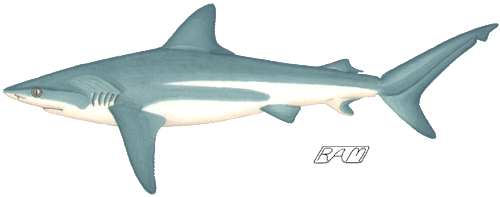The Swimming See-Saw
Shark hydrodynamics is much more sophisticated than has been traditionally believed. Most sharks have a caudal fin in which the upper lobe is considerably longer than the lower. Unlike teleost fishes, in which the backbone stops at the base of the tail fin, the vertebral column of sharks extends well into the upper lobe. This unequal arrangement, together with the fact that the wing-like pectoral fins are anterior to a shark's centre of gravity, has lead to an oversimplistic conception of shark swimming. According to the standard textbook model, the hyperextended upper lobe of the tail forces the a shark downward, which is compensated for by lift from the pectoral fins.
In reality, shark swimming is much more elegant and subtle than this kind of waterlogged teeter-totter. For starters, a shark's flattened snout and belly are also significant planing surfaces, providing up to 30% of the total lift. In addition, the lower lobe of a shark's tail is strengthened with a complex network of mineralised collagen (a highly elastic protein) fibres. The resultant collagen-powered 'snap' provides roughly as much upward thrust as the larger upper lobe provides downward — keeping the shark on an even keel. The more closely one studies shark hydrodynamics, the more wondrous these animals seem.

For example, consider that notch near the tip of the upper lobe of a shark's caudal fin. That simple-looking notch serves a sophisticated hydrodynamic function: it allows the terminal 'flap' to wag from side to side, so that the tip of the upper lobe is NOT the rearmost structure for most of the tail's propulsive arc. This virtually eliminates tail-tip vortices, resulting in reduced drag. This mechanism is imitated by winglets at the tip of aircraft wings, but our engineers can only crudely mimic the best designs of Nature. No matter how ingenious our technologies, sharks can swim circles around our state-of-the-art ships and submarines.
